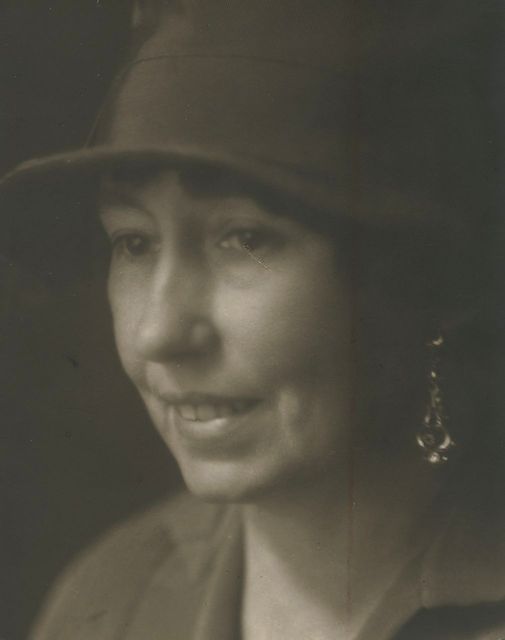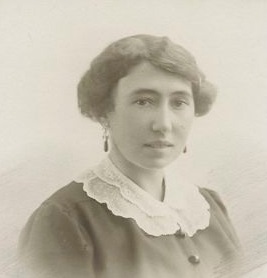Harriet Bloch was the first professional woman scriptwriter in Denmark, a career she began after seeing The Abyss/Afgrunden (Urban Gad, 1910) at the cinema. The film inspired her to write her first screenplay, as she thought she could do just as well herself. She sent her first script to Constantin Philipsen, who rejected it. Bloch then sent it to Nordisk Film, who accepted it and made the movie Hendes ære (August Blom, 1911). In the subsequent 10 years Bloch wrote more than 100 screenplays for Nordisk Film, but was never employed by the company. Not all the scripts were made into films, and for many of her works she was uncredited, as was custom at the time. At the start of her career she was paid 50 crowns for a screenplay, but her reputation grew and by the mid-1920s she could get 3,300 crowns for two scripts.
Harriet Bloch started out with no previous experience of writing. Her knowledge of movies came exclusively from the cinema, where she would watch up to three films a day before her husband came home from work and she had to have dinner ready for him and their six children. She did not consider scriptwriting to be that special, but more of a fun hobby – one that later proved to be a lucrative source of income.
In 1914 Bloch was commissioned for six screenplays by Swedish production company AB Svenska Biografteatern. The first of the titles, Love and the Journalist/Kärlek och journalistik was directed by Mauritz Stiller in 1914. Later in her career Bloch sold several scripts to Germany, with F W Murnau directing one of them, Journey into the Night/Der Gang in die Nacht, in 1921, with Dane Olaf Fønss in the lead role. Danish director Robert Dinesen also worked in Berlin at that time, and he shot her screenplay The Inheritance of Tordis/Die Erbin von Tordis (1921), about Danish King Christian VII’s lover, the courtesan Støvlet-Cathrine.
Most of the screenplays Bloch wrote for Nordisk Film were comedies. The company requested works about counts and barons and other people of society, ideally with no depictions of the proletariat. Most of her screenplays were original manuscripts, as she was full of ideas. Ole Olsen, the head of Nordisk Film, praised Bloch for her professionalism, and she was known as his favourite writer – despite never meeting him.
When Harriet Bloch sold a script, she had no say in how the film eventually turned out. She was often unable to recognize her original story in the film once the title, role list, intertitles and plot had been altered. She was at her happiest when writing scripts for Valdemar Psilander, an actor she liked a lot. At one point he wanted to play a cowboy, after which she wrote The Man Without a Future/Manden uden fremtid (Holger-Madsen, 1916) for him. When talking films came along, Harriet Bloch ended her career as a scriptwriter. Instead she wrote a few plays, although these were never performed on stage, as well as several radio plays, such as En desertør from 1938. In 1930 she bought an orchard in Ramløse, North Zealand, which she ran with her sons.
Text: DFI
(translated by Matt Bibby)
Basic info
Main profession: Screenwriter
Born: 1881
Died: 1975
Active: 1911-1923
Filmography
Manus:
Republikaneren (1923)
Fyrstinde Tatjana (1923)
Støvlet Kathrine (1921)
Elskovs Magt (1921)
Æresgæld (1921)
Kærlighed og Overtro (1920)
Frøken Larsens Karriere (1920)
Vil De være min kone i morgen? (1920)
Den skønne Ubekendte (1919)
Hendes Hjertes Ridder (1918)
Den lille Virtuos (1918)
Hjerterkonge (1918)
Pigespejderen (1918)
Prøvens Dag (1918)
Præstens Datter (1918)
Mands Vilje (1918)
Frøken Theodor (1918)
Askepot (1917)
Et Barnehjerte (1917)
Kærligheds-Væddemaalet (1917)
Tropernes Datter (1917)
De tossede Kvindfolk (1917)
Miljonarvet (1917)
Förstadsprästen (1917)
Viljeløs Kærlighed (1916)
For sin Faders Skyld (1916)
Du skal elske din Næste (1916)
Danserindens Hævn (1916)
Kærlighed og Journalistik (1916)
Manden uden Fremtid (1916)
Hendes Fortid (1916)
Kærlighed og Skræddergæld (1916)
En Kærlighedsprøve (1916)
Letsindighedens Løn (1916)
Prinsessens Hjerte (1916)
Gammel Ost og Blomsterduft (1916)
Alderdom og dårskab (1916)
Et Huskors (1915)
Lige for lige (1915)
Den lille Chauffør (1915)
Naar Hævngløden slukkes (1915)
Den sidste Nat (1915)
En søvnig Brudgom (1915)
Badehotellet (1915)
En stærkere Magt (1914)
Hægt mig i Ryggen (1914)
Et Læreaar (1914)
Den store Middag (1914)
Under falsk Flag (1914)
Frk. Studenten (1913)
Livets Blændværk (1913)
Nellys Forlovelse (1913)
Et Skud i Mørket (1913)
Kærlighed og Penge (1912)
Naar Kærligheden dør (1912)
Pro forma (1912)
Den stærkeste (1912)
Oscar Stribolt som Vidunderbarn (1912)
Gennem Kamp til Sejr (1911)
Hendes Ære (1911)
Synopsis:
Ehrenschuld (1921)
Read more about the films at the Danish Film Institute (DK)
Read more about the films at Svensk Filmdatabas (SE)


